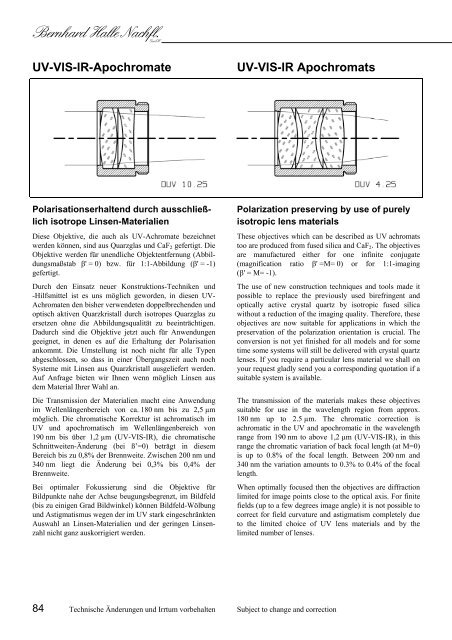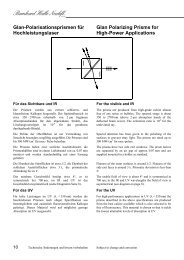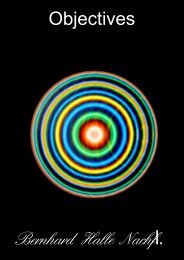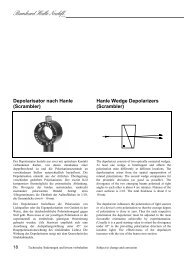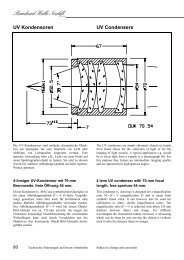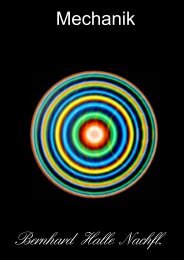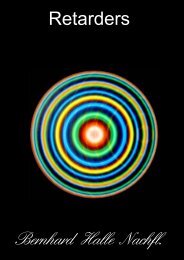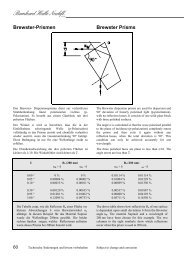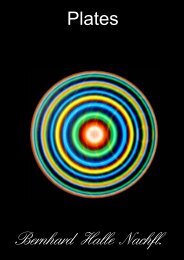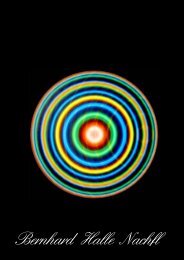Katalogauszug zu Linsensystemen - Bernhard Halle
Katalogauszug zu Linsensystemen - Bernhard Halle
Katalogauszug zu Linsensystemen - Bernhard Halle
Erfolgreiche ePaper selbst erstellen
Machen Sie aus Ihren PDF Publikationen ein blätterbares Flipbook mit unserer einzigartigen Google optimierten e-Paper Software.
<strong>Bernhard</strong> <strong>Halle</strong> Nachfl.GmbHUV-VIS-IR-ApochromateUV-VIS-IR ApochromatsPolarisationserhaltend durch ausschließlichisotrope Linsen-MaterialienDiese Objektive, die auch als UV-Achromate bezeichnetwerden können, sind aus Quarzglas und CaF 2 gefertigt. DieObjektive werden für unendliche Objektentfernung (Abbildungsmaßstabβ' = 0) bzw. für 1:1-Abbildung (β' = -1)gefertigt.Durch den Einsatz neuer Konstruktions-Techniken und-Hilfsmittel ist es uns möglich geworden, in diesen UV-Achromaten den bisher verwendeten doppelbrechenden undoptisch aktiven Quarzkristall durch isotropes Quarzglas <strong>zu</strong>ersetzen ohne die Abbildungsqualität <strong>zu</strong> beeinträchtigen.Dadurch sind die Objektive jetzt auch für Anwendungengeeignet, in denen es auf die Erhaltung der Polarisationankommt. Die Umstellung ist noch nicht für alle Typenabgeschlossen, so dass in einer Übergangszeit auch nochSysteme mit Linsen aus Quarzkristall ausgeliefert werden.Auf Anfrage bieten wir Ihnen wenn möglich Linsen ausdem Material Ihrer Wahl an.Die Transmission der Materialien macht eine Anwendungim Wellenlängenbereich von ca. 180 nm bis <strong>zu</strong> 2,5 µmmöglich. Die chromatische Korrektur ist achromatisch imUV und apochromatisch im Wellenlängenbereich von190 nm bis über 1,2 µm (UV-VIS-IR), die chromatischeSchnittweiten-Änderung (bei ß’=0) beträgt in diesemBereich bis <strong>zu</strong> 0,8% der Brennweite. Zwischen 200 nm und340 nm liegt die Änderung bei 0,3% bis 0,4% derBrennweite.Bei optimaler Fokussierung sind die Objektive fürBildpunkte nahe der Achse beugungsbegrenzt, im Bildfeld(bis <strong>zu</strong> einigen Grad Bildwinkel) können Bildfeld-Wölbungund Astigmatismus wegen der im UV stark eingeschränktenAuswahl an Linsen-Materialien und der geringen Linsenzahlnicht ganz auskorrigiert werden.Polarization preserving by use of purelyisotropic lens materialsThese objectives which can be described as UV achromatstoo are produced from fused silica and CaF 2 . The objectivesare manufactured either for one infinite conjugate(magnification ratio β' =M= 0) or for 1:1-imaging(β' = M= -1).The use of new construction techniques and tools made itpossible to replace the previously used birefringent andoptically active crystal quartz by isotropic fused silicawithout a reduction of the imaging quality. Therefore, theseobjectives are now suitable for applications in which thepreservation of the polarization orientation is crucial. Theconversion is not yet finished for all models and for sometime some systems will still be delivered with crystal quartzlenses. If you require a particular lens material we shall onyour request gladly send you a corresponding quotation if asuitable system is available.The transmission of the materials makes these objectivessuitable for use in the wavelength region from approx.180 nm up to 2.5 µm. The chromatic correction isachromatic in the UV and apochromatic in the wavelengthrange from 190 nm to above 1,2 µm (UV-VIS-IR), in thisrange the chromatic variation of back focal length (at M=0)is up to 0.8% of the focal length. Between 200 nm and340 nm the variation amounts to 0.3% to 0.4% of the focallength.When optimally focused then the objectives are diffractionlimited for image points close to the optical axis. For finitefields (up to a few degrees image angle) it is not possible tocorrect for field curvature and astigmatism completely dueto the limited choice of UV lens materials and by thelimited number of lenses.84 Technische Änderungen und Irrtum vorbehalten Subject to change and correction


